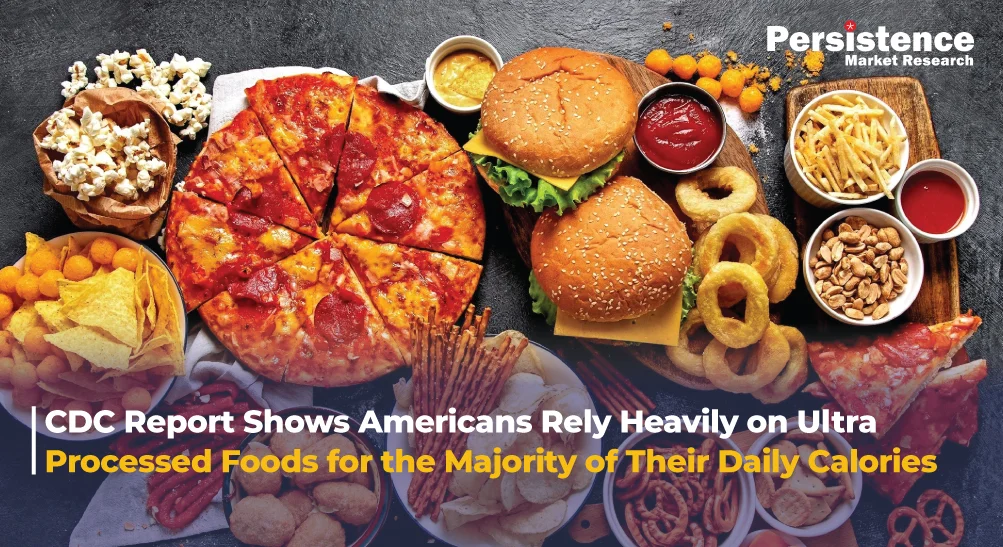- Blog
- Ultra Processed Foods Top Trends
CDC Report Shows Americans Rely Heavily on Ultra Processed Foods for the Majority of Their Daily Calories
Published On : 10 Sep 2025
A recent analysis by the Centers for Disease Control and Prevention (CDC) has revealed a striking dietary trend in the United States: Americans aged one and older derive 55% of their daily calories from ultra-processed foods (UPFs). The impact is even more pronounced among children and adolescents, who consume approximately 61.9% of their calories from these products. These figures highlight a significant shift in dietary patterns and raise concerns among public health experts regarding long-term health implications.

What are Ultra-processed Foods?
Ultra-processed foods are industrially manufactured items that contain little or no whole food. They often include additives, sweeteners, emulsifiers, and preservatives, which are designed to enhance flavor, appearance, and shelf life. Common examples include sugary beverages, packaged snacks and baked goods, ready-to-eat frozen meals, and convenience sandwiches. These products are typically energy-dense and low in fiber and essential nutrients, while being high in added sugar, salt, and unhealthy fats.
What Does CDC Analysis on Ultra-Processed Food Tell?
- The CDC’s analysis of data from 2021 to 2023 underscores the prevalence of UPFs in the American diet. Overall, more than half of the calories consumed by people aged one and older come from ultra-processed foods. Among youth aged 1–18, the proportion rises to nearly 62%, while adults consume slightly over 53% of their calories from these foods. The most significant contributors include sandwiches, sweet baked products, savory snacks, pizza, and sugar-sweetened beverages. Although the share of calories from UPFs has decreased slightly compared to previous surveys, the overall consumption remains alarmingly high.
- Public health experts are concerned because high intake of ultra-processed foods is associated with negative health outcomes. Studies have consistently linked higher UPF consumption to increased risks of obesity, cardiovascular disease, and all-cause mortality. Ultra-processed foods are designed to be hyperpalatable, making it more challenging for both adults and children to maintain healthy dietary patterns.
- The White House has also drawn attention to this issue. In 2025, a report led by Health and Human Services Secretary Robert F. Kennedy Jr. emphasized the role of ultra-processed foods in chronic disease. The report recommended policy measures to reduce UPF exposure, including improved school nutrition programs, enhanced labeling and marketing regulations, and broader reforms within the food system. These findings have fueled renewed public and policy discussions about the importance of promoting diets rich in whole, minimally processed foods.
- While systemic changes are necessary, individuals can take practical steps to reduce UPF consumption. Simple strategies include substituting flavored instant oats with plain oats, replacing packaged snacks with fresh fruit, preparing batch-cooked meals from whole grains, vegetables, and lean proteins, and choosing water or unsweetened beverages over sugar-sweetened drinks. Reading ingredient labels carefully and minimizing foods with refined sugars, syrups, and unfamiliar additives can also help in making healthier choices.
Conclusion
In conclusion, ultra-processed foods now constitute more than half of the calories consumed by Americans, with children and adolescents being particularly affected. Although modest declines in UPF consumption have been observed, the overall prevalence remains high, underscoring the importance of both public health interventions and individual dietary choices. By gradually increasing the intake of whole grains, fruits, and vegetables while reducing reliance on packaged and processed items, individuals can make meaningful improvements to their long-term health.
Industry Report

Request Report Sample
Your privacy is important to us; your data is secure
Contact Us
Latest Reports
-
Piezoresistive Pressure Sensor Market by Sensor Type (Absolute, Gauge, Differential, Sealed), Pressure Range (Low Pressure (<10 kPa), Medium Pressure (10 kPa – 1000 kPa), High Pressure (>1000 kPa)), End-Use Industry (Automotive & Transportation, Industrial Manufacturing, Healthcare, Aerospace & Defense, Electronics) and Regional Analysis for 2026-2033
-
Aquarium Accessories Market by Product Type (Filtration Items, Lights & Hoods, Temperature Control Systems, Others), End-User (Residential, Commercial), Distribution Channel (Online, Offline), and Regional Analysis for 2026-2033
-
Oxygen Therapy Market by Product Type (Compressed Oxygen, Concentrated Oxygen, Liquid Oxygen), Disease (Respiratory Disorder, Cardiovascular Disease, Sleep Apnea, Pneumonia), End-User (Hospitals, Home Healthcare, Clinics), and Regional Analysis for 2026-2033
-
Air Curtains Market by Product Type (Non‑Recirculating, Recirculating, Heated, Others), Airflow Capacity (Up to 500 m³/h, 500–1000 m³/h, 1000–1500 m³/h, Above 1500 m³/h), Application (Commercial, Industrial, Residential, Others), and Regional Analysis for 2026–2033
-
Personalized Stationery Market by Product type (Storage & Filling Products, Paper-Based Products, Drawing & Writing Instruments, Accessories, Bags, Others), Application (Educational Institutes, Corporate Offices, Personal Use, Hospitals, Others), and Regional Analysis for 2026–2033
